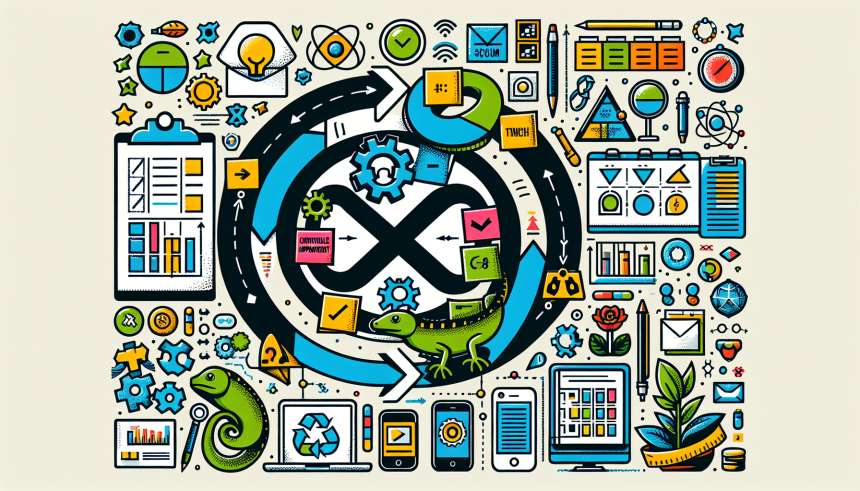Unpacking the Agile Software Development Lifecycle: Key Principles and Practices
Understanding the Agile Methodology
Agile software development is an iterative approach that emphasizes flexibility, collaboration, and customer-focused delivery. Unlike traditional methodologies, such as the Waterfall model, Agile enables teams to respond to change rapidly and effectively through a series of incremental work phases.
The Agile Manifesto, established in 2001, outlines core values and principles that shape Agile practices. The four foundational values emphasize:
- Individuals and interactions over processes and tools: Prioritizing strong team dynamics and open communication.
- Working software over comprehensive documentation: Delivering functional software that meets user needs is more critical than exhaustive documentation.
- Customer collaboration over contract negotiation: Engaging stakeholders throughout the development process fosters better end products.
- Responding to change over following a plan: Flexibility in adapting to changes will yield more effective results during development.
Key Principles of Agile
The guiding principles derived from the Agile Manifesto encourage a transformative approach to software development. These include:
-
Customer Satisfaction: Providing continuous delivery of valuable software should be the primary focus. Early and frequent releases help ensure the end product aligns closely with customer needs.
-
Embracing Change: Agile welcomes changes in requirements, even late in the development cycle. This adaptability enhances the product’s relevance in a fast-paced environment.
-
Frequent Delivery: Working increments of software should be delivered regularly, from a couple of weeks to a few months, ensuring incremental progress toward the final product.
-
Collaborative Environment: Regular interaction between business stakeholders and developers is vital. This cooperation leads to a clear understanding of project goals.
-
Motivated Teams: Agile relies on self-organized teams, where members are encouraged to collaborate effectively. A supportive environment increases enthusiasm and productivity.
-
Technical Excellence: Maintaining a high standard in technical clarity and quality enhances Agile processes. It simplifies future development and reduces technical debt.
-
Sustainable Development: Agile promotes a pace that can be sustained indefinitely. Teams should strive for consistency between development efforts and their capacities.
The Agile Software Development Lifecycle (ASDL)
The Agile Software Development Lifecycle consists of several phases that reflect the iterative nature of Agile practices. Understanding these phases is crucial for implementing Agile methodologies effectively.
1. Concept/Inception Phase
In this initial phase, the product vision is defined. Stakeholders engage in discussions to outline user requirements and establish business value. Key activities include:
- Identifying project goals
- Gathering customer feedback
- Creating a high-level project scope
- Developing a project roadmap
2. Iterative Development
The iterative development phase encapsulates the core of Agile methodology. Here, products are developed in short iterations, or sprints, typically lasting 1 to 4 weeks. This process includes:
- Sprint Planning: Teams prioritize the product backlog and define sprint goals.
- Daily Stand-ups: Short daily meetings help track progress and obstacles.
- Development Work: Teams execute their tasks, focusing on delivering a working increment of the software by the end of the sprint.
- Sprint Review: At the end of each sprint, teams demonstrate the completed work to stakeholders, gathering immediate feedback for next iterations.
3. Testing and Quality Assurance
Testing plays a pivotal role throughout the Agile process. Continuous testing ensures immediate feedback on code changes and helps maintain software quality. Practices include:
- Automated Testing: Automated tests can quickly verify functionalities with each deployment, reducing manual testing efforts.
- Continuous Integration/Continuous Deployment (CI/CD): CI/CD tools streamline the release process, enabling regular deployment of software updates.
4. Release Planning
After several iterations, a release planning phase occurs to prepare for delivering the product to users. This includes:
- Finalizing the product increment
- Analyzing testing results
- Conducting user acceptance testing (UAT)
- Preparing release notes and documentation
5. Production/Delivery Phase
Once the release is approved, the product is delivered to the end-users. Support teams assist in managing the rollout, ensuring user adoption and satisfaction.
6. Review and Feedback
Post-delivery feedback is crucial for future iterations. Teams often conduct retrospectives to reflect on processes, assess team performance, and identify areas for improvement. These insights guide subsequent development and adjustments.
Agile Practices and Frameworks
Various Agile frameworks offer methodologies for implementing Agile principles. The most popular among these include:
-
Scrum: A widely-used framework that organizes work into sprints, encourages regular collaboration, and fosters accountability through defined roles like Scrum Master and Product Owner.
-
Kanban: Focused on visualizing work, Kanban utilizes boards to manage tasks and optimize workflow. This practice allows teams to limit work in progress and improve efficiency.
-
Extreme Programming (XP): XP emphasizes technical excellence through practices like pair programming, continuous integration, and extensive automated testing. It prioritizes customer involvement throughout the development process.
-
Lean Software Development: Originating from Lean manufacturing principles, this approach aims to eliminate waste, optimize processes, and enhance value delivery to customers.
Conclusion
While the Agile methodology and its lifecycle present straightforward principles, successfully implementing them demands a cultural shift. Organizations must adapt their mindsets to thrive within Agile frameworks, embracing collaboration, customer engagement, and continuous improvement. By understanding the Agile Software Development Lifecycle, teams can foster innovation and deliver software that genuinely meets user needs.


